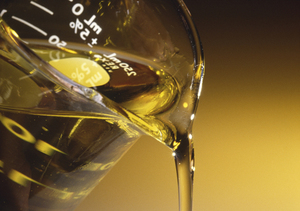When the wax finish on your car is still good, rain droplets will ‘bead-up’ and not really wet the surface as they are repelled by the wax. The impermeability of the wax on the car’s body and the surface tension in the rain droplets keep the water from ‘wetting’ the surface. Surface tension can be described as the contractive tendency of the surface of a liquid.
The same can be said for pesticides, particularly those that are water based such as glyphosate and the hormone herbicides. Water has a higher water surface tension than the oily/waxy layers of the plant surface. Hence, it seems logical that any surfactant (surface acting agents) that reduces surface tension and so enables the spray droplet to spread will improve herbicide performance. Sadly it isn’t as simple as that.
Reducing surface tension to as low as possible can result in droplets running off the leaf as the droplets coalesce (due to very low surface tension). Some surfactants may reduce surface tension to the point where the spray droplet is spread over such a large area that it dries too quickly, reducing uptake of an active ingredient that may need to be in the semi-liquid state to be absorbed.
So, there is a great danger in the assumption that the better the spread of droplets the better the activity of the pesticide. An additional issue is that having too much surfactant in the sprayed liquid can lead to damage to the plant surface, inhibiting herbicide uptake.
As I said last week (Have we got it?), in experiments the really big benefits of adding the surfactant ethoxylated tallow amine are only recorded at doses that are so low as to give unsatisfactory control, even after its addition.
Research in France suggests that, even when sprayed in water that is typically marginally harder than anything we get from the tap, the benefits of adding this surfactant for the control of volunteer barley are not really apparent until the doses of the glyphosate 360 g/l formulations tested were reduced to 2.0 l/ha applied in a spray volume of 200 l/ha. The same concentration of surfactants from the formulation would be present in 1.0 l/ha product in a spray volume of 100 l/ha but crucially the actual dose/ha is still halved.
Other French research suggests that the addition of ethoxylated tallow amine surfactants to 1.0 l/ha of a 360 g/l product significantly increases spray retention when applied in a total volume of 150 l/ha.
The issue has moved on over recent years. There are some concerns over the use of ethoxylated tallow amines and many of the most recent formulations contain other surfactants. Alternative surfactants to ethoxylated tallow amine include the ethoxylated rapeseed oil surfactants.
However, some recent German, French and American research suggests that great care needs to be taken to get the right form of these surfactants. This research clearly demonstrates the danger of having a spray solution with too low a surface tension i.e. the droplets spreading too much.
A German laboratory study identified the most biologically effective spray solution produced from mixing the unformulated glyphosate salt (the active substance) with individual ethoxylated rapeseed oil surfactants chosen from a range that differed in their impact on the surface tension of the spray droplet i.e. their level of ethoxylation. The most biologically effective surfactant was one that only marginally increased the spread of the droplet (when compared to the unformulated glyphosate salt) on easy to wet plants (e.g. chickweed and pansy) but did not increase the droplet spread on difficult to wet plants (e.g. fat-hen).

The improved weed control resulted from minimising the glyphosate ‘footprint’ on the plant surface. This created very small but highly concentrated areas covered by glyphosate. The better biological activity may be attributed to a higher concentration gradient between the drying deposit on the outside of the plant and the xylem and phloem inside the plant.
In this German study, the droplets were applied individually and all were retained by the target plant. However, there have been field trials in France and the US which confirm that rapeseed oils with the same level of ethoxylation as those identified in the German study can be effective formulants or spray additives to some existing glyphosate formulations. The key is that the level of ethoxylation of these rapeseed oils has to be high. The most effective ethoxylated tallow amine additives are also those with a high level of ethoxylation.
So, the assumption that the most effective pesticide formulations are those that result in the maximum spread or coverage of the plant surface is truly blown by this research on glyphosate. I’m sure that the same must apply to some other pesticides, but of course not all pesticides. It’s the same old message; no one adjuvant is a good partner to all pesticides and certainly, in some cases, at least it’s not worth making water much wetter.
